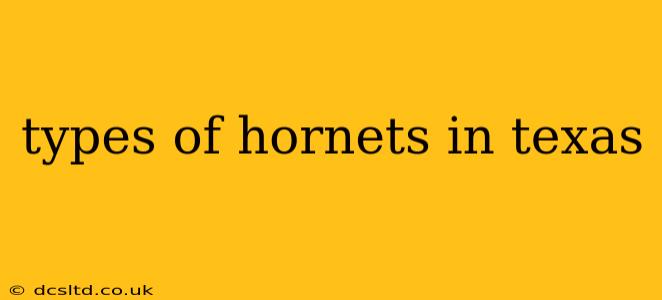Texas, with its diverse climate and ecosystems, is home to several hornet species. Understanding these stinging insects is crucial for safety and appreciating the role they play in the environment. This guide will explore the common types of hornets found in the Lone Star State, their identifying characteristics, and how to handle encounters responsibly.
What Types of Hornets Live in Texas?
While the term "hornet" is often used loosely, true hornets belong to the genus Vespa. In Texas, the most prominent representatives are the European hornet (Vespa crabro) and, less commonly, the bald-faced hornet (Dolichovespula maculata), although the latter is technically a yellowjacket. Confusion arises because both are large, social wasps often mistaken for each other. It's important to note that many other stinging insects, like yellow jackets and paper wasps, are frequently misidentified as hornets.
1. European Hornet (Vespa crabro)
The European hornet is the most commonly encountered "true hornet" in Texas. It's a large wasp, easily recognized by its reddish-brown head and thorax, with yellowish-brown and black striped abdomen. They are relatively docile unless provoked, defending their nests aggressively if threatened. Their nests are usually found in tree hollows, wall voids, or other sheltered locations.
2. Bald-faced Hornet (Dolichovespula maculata)
Often mistaken for a hornet, the bald-faced hornet is actually a type of yellowjacket. They are easily identified by their predominantly black bodies with white markings on their face and abdomen. Their nests are characteristically large, gray papery structures, often suspended from tree branches or building eaves. Unlike European hornets, bald-faced hornets can be more aggressive in defending their nests.
What are the Differences Between Hornets, Yellow Jackets, and Wasps?
This is a common question, and the distinctions can be subtle. Here's a breakdown:
-
Hornets (Genus Vespa): Generally larger than yellow jackets and wasps, with a more robust body. They often build enclosed nests. In Texas, the European hornet is the main example.
-
Yellow Jackets (Genus Vespula and Dolichovespula): Smaller than hornets, with predominantly yellow and black markings. They often build nests underground or in wall voids, and are known for their aggressive nature. The bald-faced hornet is a notable exception, building above-ground nests.
-
Wasps (Various Genera): This is a broad category encompassing many species. They vary greatly in size, color, and nesting habits. Paper wasps, for example, build open-comb nests under eaves or on structures.
How to Identify a Hornet Nest?
Identifying a hornet nest is crucial for safety. European hornet nests are typically enclosed, often found in cavities like tree hollows or within walls. Bald-faced hornet nests are large, gray, papery structures, usually hanging exposed from branches or building structures. Both types of nests should be avoided unless handled by a professional pest control service.
Are Hornets Dangerous?
While hornets can sting and their stings are painful, they are not inherently aggressive. They primarily sting when threatened or defending their nests. However, multiple stings can be dangerous, especially for those allergic to venom. Therefore, maintaining a safe distance and avoiding provoking them is essential.
What to Do if You Encounter a Hornet?
- Remain calm: Sudden movements can provoke them.
- Slowly back away: Avoid swatting or running.
- Seek shelter: If you feel threatened, find a safe place indoors.
- Contact pest control: If you discover a nest near your home or workplace, contact a pest control professional for safe removal.
This guide offers a comprehensive overview of hornets in Texas. Remember, accurate identification is key to managing interactions responsibly. For serious stings or allergic reactions, always seek immediate medical attention.
